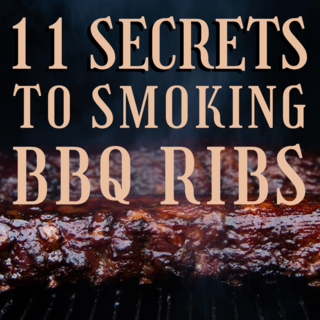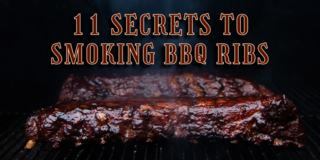The 11 Secrets to Smoking BBQ Ribs

Want to know how to smoke a terrific rack of ribs? This finger-lickin’ staple of summer back yard dining can seem daunting, for sure. Ribs should be tender, without falling off the bone. They should have a little tug when you bite into them, without being tough. BBQ ribs should have rich, porky flavor that doesn’t rely heavily on barbecue sauce. But how do you get your ribs to that perfect point? Don’t worry. We’ve done the legwork, read the articles, watched the videos, and picked the brains of our in-house kitchen staff. We can help you figure out what temperature to smoke ribs at, how long to smoke your ribs, and give you tips on which ribs to choose and how to add a ton of flavor. Here’s our list of the most important steps for you to take on the path to knockout smoked ribs.
- Start with a great cut of meat. For smoking, we like a basic rack of spareribs, minimally trimmed to enjoy maximum meaty goodness. The meat on a rack of spareribs can be tough, so look for meat that’s got even striations of fat marbling through the meat, which will render during cooking and help make the ribs tender, succulent, and juicy. You can trim off any obvious globs of fat or connective tissue clinging to the ends of the meat, and get rid of the thin flap of meat—the “skirt”—that hangs diagonally off the bone side of the ribs. If you get your pork from a butcher, she or he should be willing to trim the rack for you. We do recommend getting ribs from a butcher if you can; if you get them at a grocery store, try to get ribs that aren’t packaged in liquid or frozen. See if you can find Heritage or Berkshire pork. Fresh is best, and fresh ribs should be eaten within a day or two of purchase.
- Remove the membrane off the back of the rib. A tough strip of connective tissue covers the back (bone) side of a rack of ribs. Also known as the silverskin, this membrane is not as porous as the rest of the meat, so if it’s attached the smoke won’t penetrate the meat as evenly. You want to pull the silverskin up, not pierce it, so use a butter knife or other dull kitchen tool (like a small spreading spatula) to slip between the silverskin and the flesh of the ribs. Pull up one corner and then grab the membrane and pull. Silverskin may be slippery; give your fingers some extra traction by using a paper towel to grip the lifted flap of skin. Pull it back toward you in a smooth motion.
- Coat your trimmed rack of ribs in a dry rub. You can create your own rib rub recipe that reflects your own tastes, or buy one that you like and use that. Pat the ribs dry with a paper towel before applying the rub, and plan to use about a tablespoon of rub per pound of meat. Make sure all sides are covered with rub. Let it sit out on your kitchen counter for about an hour. Pat, don’t rub or pound, the seasoning onto the meat. Let the seasoned ribs sit on the counter for about an hour or so. You do not need to let them sit overnight in the refrigerator. If, in the interests of time, it’s easier for you to prep the ribs the night before and let them sit, it won’t hurt them. But it’s not necessary. We do not recommend marinating the ribs.
- While your ribs sit in the seasoning, put wood chips in your smoker, turn it on and let it come up to temperature. If you want a milder smoke flavor choose a sweet, fruit wood, like cherry, apple, or peach wood. If you want a more intense smoke use oak, mesquite, or hickory. If you’re using a wood chunk smoker, your smoke should be thin and blue when you put the meat on the fire, not white and billowing. Billowing smoke can easily overwhelm the meat and turn it bitter. Pellet smokers don’t produce billowing clouds of smoke, so you can start cooking on that as soon as you feel that the temperature is correct.
- There are two, pretty evenly split, camps regarding cooking temperature and time. One advocates smoking ribs using the 3 2 1 method.This low-and-slow ribs method requires a smoking temperature of 225° F. The ribs are smoked at this temperature for three hours, tenderized in a wrap for two hours, and then finished, unwrapped, for one hour. Voila! 3 2 1 ribs! The method we’re working with requires a higher cooking temperature of 275° F; the ribs are smoked for approximately two hours, wrapped for one, and finished for about half an hour. Smoking is an inexact science so all cooking times are educated guesses. The ribs will be done only when they are done, and the best way to understand when they’re done is simply to pay attention to them.
- During the initial smoking period, spray or mop the ribs at the end of the first hour in order to help the ribs stay juicy. The ribs should be meat-side up during this time, and the lid of the smoker should remain closed except when mopping. Leave the ribs in to continue smoking for about another hour or so, with the lid closed. They are ready to move forward to the next step when the internal temperature of the ribs reaches between 160°-165°F.
- At the end of the smoking period, wrap the ribs in a double-layer of foil. Baste them first with another coating of the mopping liquid, then put them in the foil meat-side down and seal it. We don’t advocate adding anything that will create an abundance of liquid in the foil packet, because that can steam the ribs too aggressively and overcook them to the point that the meat gets mushy. Put the wrapped ribs back in the smoker and leave them in there for an hour.
- Unwrap the ribs. At this point you should see clear definition between the bones, because the meat will have contracted since so much of the fat has rendered out. Remove the foil and throw it out, along with any juices that have collected in the foil. Give them another basting with the mop and put them on the smoker one last time, meat side up, for the final stage of cooking This stage will take 30 minutes to 1 hour. You can put a light layer of your favorite barbecue sauce on the top of your ribs during this final cook to create a glaze, but that should be go on only 15 minutes or so before doneness, so the sauce doesn’t burn.
- Ribs are done when they reach an internal temperature of 195-200° F. Pork is safe to eat at an internal temperature of 145° F, but that will not provide sufficient heat for the connective tissue to break down fully and create juicy, succulent ribs. To test for doneness, you can do the crack test—pick the ribs up by their sides and bend the sides toward each other. If the center feels like it’s about to crack, the ribs are done.
- Let the ribs rest for at least 10 minutes before eating, so the juices in the ribs that are pulled toward the surface because of heat can redistribute throughout the meat, creating a bite that is tender all over.
- Turn the ribs over, meat side down, to slice. The bones, and the meaty spaces between the bones that you can slice through, are much more evident on the underside of the rack. Serve with sauce on the side, your favorite cool drink, and a pile of napkins. Enjoy!

